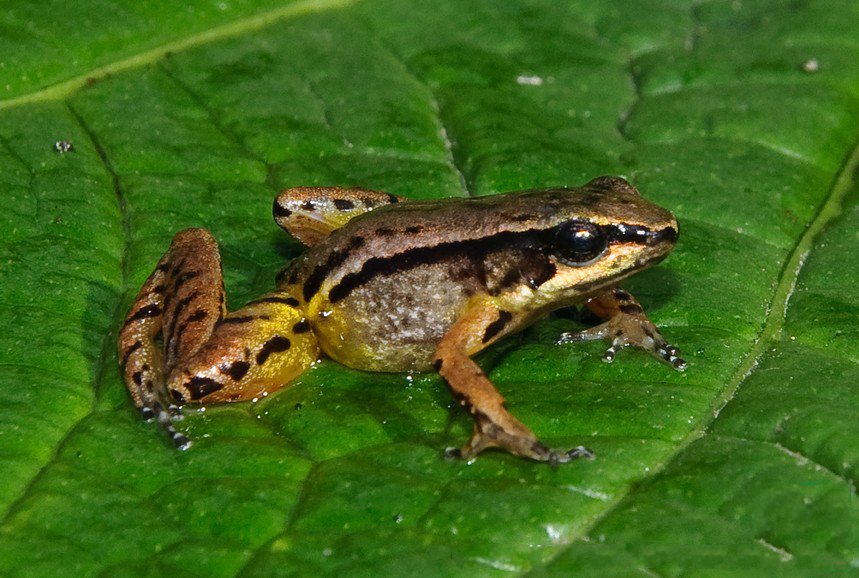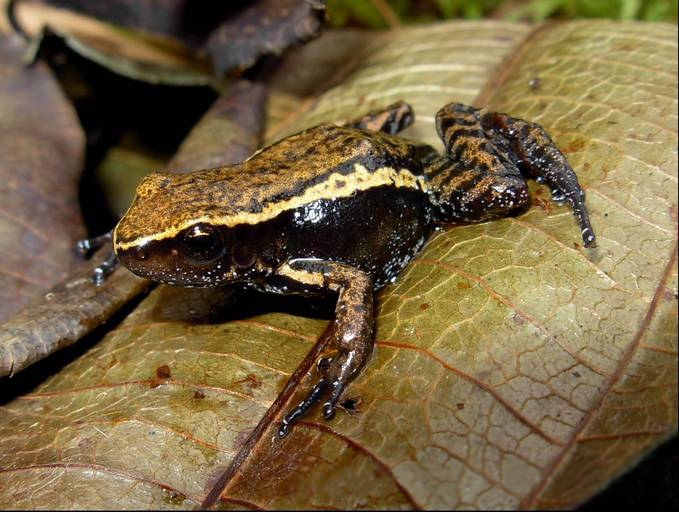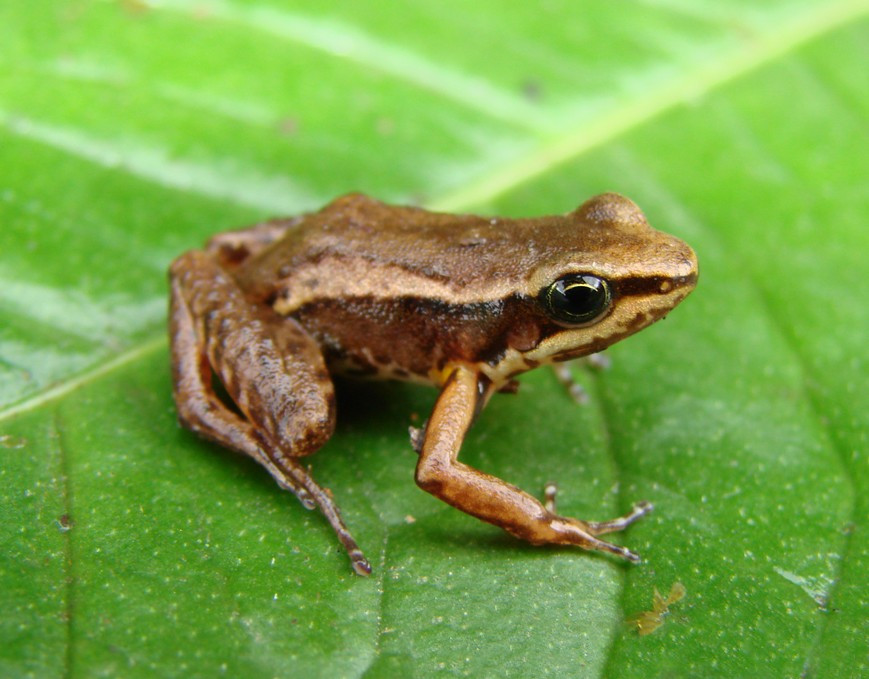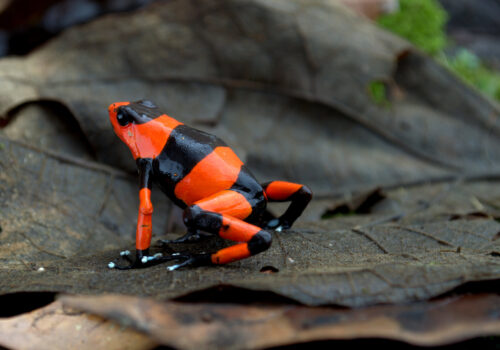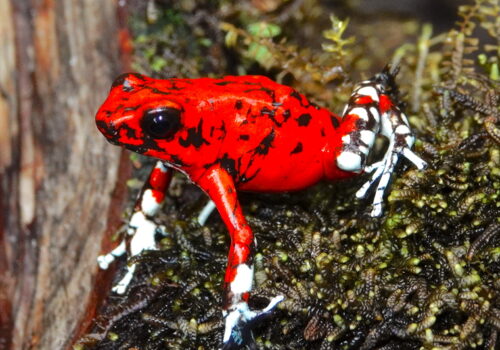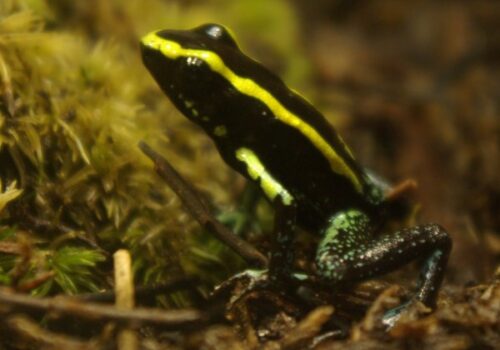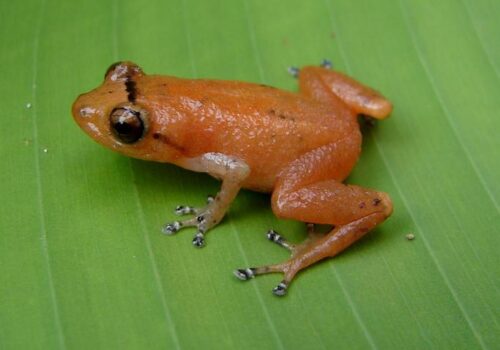- Hyloxalus subpunctatus: Discovering Colombia's Secretive Stream Dweller
- Understanding the Family: Taxonomy and Classification of Hyloxalus subpunctatus
- The Secret Streams: Natural Habitat of Hyloxalus subpunctatus
- A Closer Look: Physical Characteristics and Adaptations
- From Streamside Songsters to Devoted Parents: Behavior and Life Cycle
- A Keystone in Miniature: Ecological Role and Importance
- A Fragile Future: Threats and Conservation Challenges
- Beyond the Stream: Cultural and Scientific Insights
- Championing Colombia's Tiny Amphibian Treasure
Hyloxalus subpunctatus: Discovering Colombia’s Secretive Stream Dweller#
Hidden among the mist-drenched montane forests and sparkling streams of Colombia’s Andean slopes lives a fascinating yet seldom-celebrated creature. The frog known scientifically as Hyloxalus subpunctatus is a small, mysterious amphibian whose understated charm belies its ecological significance. A member of the family Dendrobatidae, often called poison dart frogs, this diminutive species doesn’t sport the vibrant hues you’d expect of its more notorious kin. Instead, it bears subtle markings and earthy tones, perfectly suited to its secretive existence amidst leaf litter and damp rocks.
Despite its modest appearance, Hyloxalus subpunctatus plays an indispensable role as a bioindicator, signaling the health of fragile montane ecosystems where biodiversity flourishes yet remains vulnerable. Intrigued yet? Let’s embark on a journey into the misty slopes and sparkling streams to uncover the quiet yet critical life of this captivating amphibian.
Understanding the Family: Taxonomy and Classification of Hyloxalus subpunctatus#
Hyloxalus subpunctatus belongs to the class Amphibia, order Anura, family Dendrobatidae—commonly known as poison frogs or dart frogs. Within this family, the genus Hyloxalus encompasses several species primarily occupying Andean regions. Unlike some of its vividly colored relatives like Dendrobates tinctorius or Oophaga pumilio, Hyloxalus subpunctatus embodies more subdued coloration.
The species epithet “subpunctatus” derives from Latin, referencing the subtle spotted patterns characteristic of their skin. Originally described scientifically in the early 20th century, its classification has seen adjustments alongside advancements in genetic research and ecological understanding. Closely related species such as Hyloxalus vertebralis and Hyloxalus edwardsi share similar microhabitats, making taxonomy and accurate identification critical to ecological research and conservation efforts.
The Secret Streams: Natural Habitat of Hyloxalus subpunctatus#
Hyloxalus subpunctatus flourishes in the pristine yet fragile ecosystems of Colombia’s Andean forests, predominantly between altitudes of 1,000 and 3,000 meters above sea level. Within this altitude range, they find their niche along shaded, clear streams coursing through dense cloud forests rich in mosses, broad-leaved plants, and epiphytic growth.
Protected from the harsh sunlight by thick forest canopies, their habitats experience high humidity, cloud cover, and steady rainfall—conditions essential for maintaining moist skin and healthy populations of prey species. These secluded streams and adjacent leaf litter provide perfect concealment, helping deter potential predators and shielding these elusive amphibians from easy detection.
A walk through their natural territory brings forth a sensory spectacle: the crisp, fresh air scented by decaying foliage and damp earth, the gentle symphony of trickling water mingling with the chorus of hidden amphibians, and glimpses of verdant moss sparkling from perpetual mist. Such tranquil habitats, yet undeniably vulnerable to human interference, offer sanctuary and sustenance to this delicate amphibian and countless other species sharing their home.
A Closer Look: Physical Characteristics and Adaptations#
Lacking the flamboyance typical of many poison dart frogs, Hyloxalus subpunctatus showcases a subtler beauty. Adult frogs typically measure between 17 and 25 millimeters in length—slightly smaller than an adult human thumb. Their bodies exhibit tones of olive green, brown, beige, or gray, often speckled or subtly striped for camouflage within their moist, shadowy habitats.
The smooth, moist skin not only offers protection and camouflage but plays a crucial role in respiration and moisture absorption. Tiny glandular secretions on their skin provide mild defensive toxins, deterring predators without the potent virulence found in more brightly colored poison frogs.
Limbs slender yet robust, toes equipped with special gripping pads—these adaptations afford them extraordinary agility, enabling rapid, precise movements across slippery rocks and damp vegetation. A dark, eye-stripe running from nose tip to shoulder often adorns their face, creating a distinctive look that, coupled with the intricate spotted or speckled patterns along their flanks and back, make them easily recognizable to knowledgeable observers, despite their elusive tendencies.
From Streamside Songsters to Devoted Parents: Behavior and Life Cycle#
Feeding and Hunting Habits#
Hyloxalus subpunctatus primarily hunts small insects such as ants, beetles, mites, and other arthropods abundant in decomposing leaf litter and along stream banks. Their hunting strategy involves patient stillness punctuated by lightning-speed movements, rapidly flicking out sticky tongues to capture unsuspecting prey.
This diet rich in arthropods helps maintain ecological balance, controlling insect populations and contributing to nutrient cycling within these vibrant forest systems.
Breeding and Parental Care#
Reproductive strategies of Hyloxalus subpunctatus are notably sophisticated and indicative of a deep evolutionary narrative. Males stake territorial claims, awaiting females and advertising readiness through a streamside chorus—a series of soft, rhythmic calls echoing amidst trickling water.
Following successful mating, females deposit clusters of eggs (typically numbering 8-20 eggs) within moist leaf litter close to water bodies. This choice of site guards developing embryos from potential desiccation and predators. However, the real wonder of their reproductive strategy lies in parental involvement. Fathers, remarkably protective, return periodically to hydrate and monitor developing embryos. Once hatched, tadpoles climb onto their parent’s back—usually the male—who carefully transports his aquatic charges into nearby streams or pools of still water suitable for further larval development.
During this aquatic stage, tadpoles subsist on algae, microbial films, and detritus. After several weeks, tiny froglets metamorphose, transitioning from the aquatic domain to their terrestrial lives, initiating the cycle anew.
A Keystone in Miniature: Ecological Role and Importance#
Even small organisms can anchor entire ecosystems, and Hyloxalus subpunctatus exemplifies this ecological truth. As both predators and prey, they maintain stability within complex food webs. By consuming insect populations, they help regulate arthropod abundance, indirectly benefiting plant communities by keeping herbivorous insect populations under control.
Simultaneously, these frogs serve as vital prey items for numerous larger predators—including snakes, birds, and small mammals—supporting overall forest biodiversity. Their sensitivity to environmental change grants them an essential role as bioindicators, offering early warnings of ecological disruptions caused by pollution, habitat loss, or climate variations.
A Fragile Future: Threats and Conservation Challenges#
Despite their adaptability, Hyloxalus subpunctatus faces escalating threats. Extensive habitat destruction from logging, agriculture expansion, mining activities, and urban encroachment degrades their pristine environments. Moreover, global climate change threatens to alter precipitation patterns, elevating risks of drought, flooding, and temperature fluctuations incompatible with the species’ survival.
The IUCN currently classifies Hyloxalus subpunctatus as Least Concern—a deceptively reassuring label masking potential localized declines due to habitat fragmentation and changing climatic conditions. Vigilant monitoring and habitat preservation remain paramount in preventing future conservation crises, underscoring the importance of scientific research, protected area establishment, and community involvement in Andean conservation initiatives.
Beyond the Stream: Cultural and Scientific Insights#
Locally, these frogs lack the infamous status granted to their vividly colored relatives historically employed for dart poisoning—yet culturally, they represent integral components of Colombia’s treasured biodiversity. Scientifically, studies involving Hyloxalus subpunctatus have improved understanding of amphibian vulnerability to climate change, habitat alteration, and chytrid fungal disease, a significant global threat to amphibians.
Championing Colombia’s Tiny Amphibian Treasure#
Hyloxalus subpunctatus reminds us that even the smallest, quietest creatures profoundly shape our ecosystems’ health and our shared future. Their perseverance among misty mountain streams, concealed yet vital, symbolizes the intricate interconnections binding all life. By advocating for and safeguarding their fragile Andean habitats, we honor nature’s diversity and guarantee a brighter future for all species—ourselves included.
Inspired to make a difference? Dive deeper by exploring conservation organizations working tirelessly to protect Colombia’s amphibians and their vibrant ecosystems, and consider supporting or contributing to ecological guardianship for species as remarkable—and as humble—as Hyloxalus subpunctatus.
